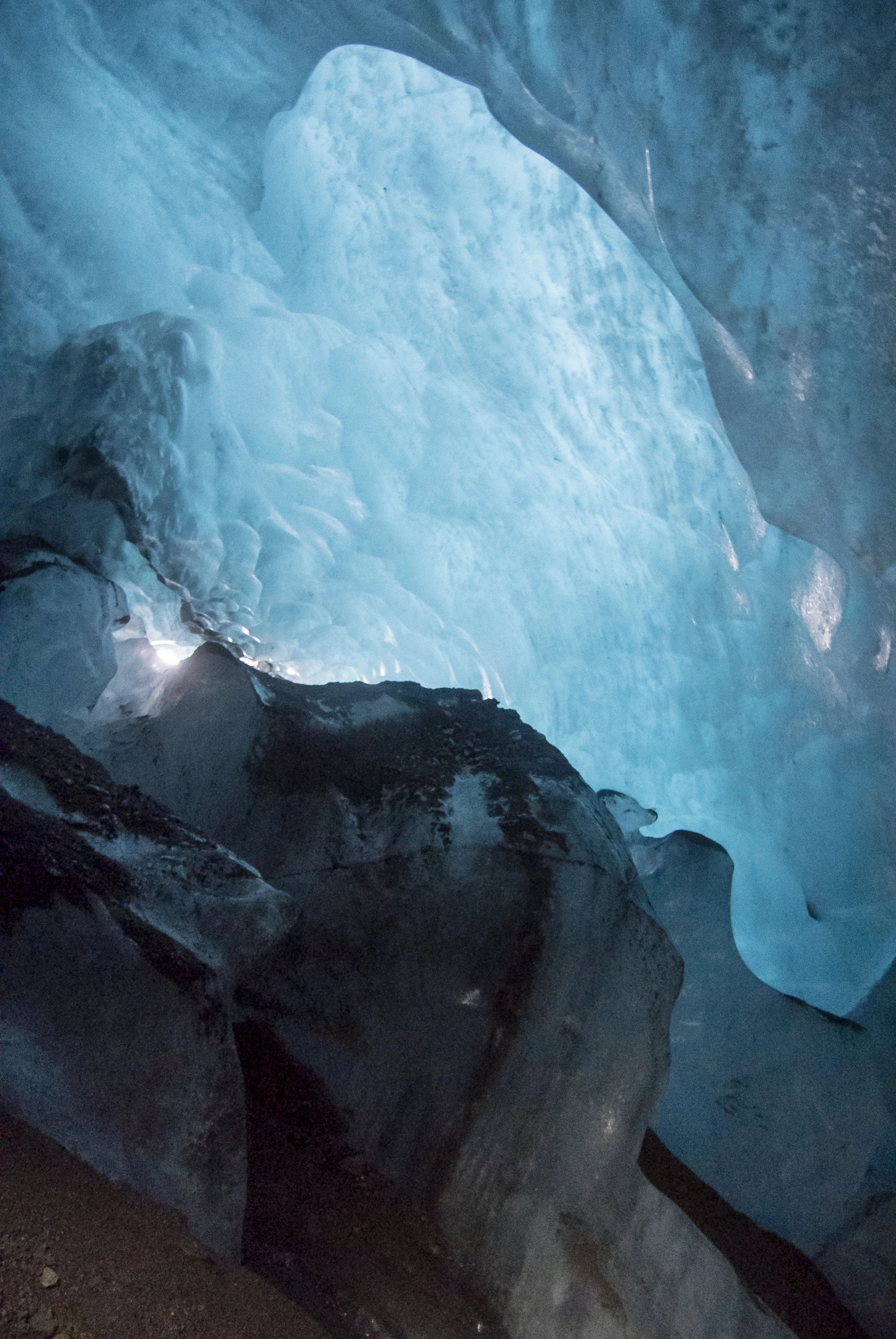Lava and ice
We started out before the sun was up (which isn’t terribly early I suppose when sunrise is close to 9:30) and made the relatively short drive to Glacier Guides. The clouds had lifted enough to reveal a gorgeous range of mountains, draped in rugged glaciers, in shades of blue in the morning light. We were fitted for crampons and given a helmet and an ice axe before piling into a large bus to be driven to Falljökull (pronounced something like “fat yoghurt”), which translates to “falling glacier”. We hiked for about 30 minutes to the foot of the glacier, where our guide explained how to strap on and use our crampons.
It was definitely a bit disconcerting taking the initial icy steps onto the glacier. I will say those crampons are an amazing invention, allowing us to walk across ice with relative ease, admittedly with a bit of an odd gait. Our guide entertained us on our hike with facts about glaciers, such as the fact they’re actually formed from compacted snow (something like 30 feet of snow compresses into about an inch of glacial ice) and they move something like 8 inches a day. We hiked up ice stairs that had been carved into the glacier, with the help of rope railings strung along, and eventually stood atop metres and metres of ice, looking out at the lava fields we had just hiked through. It was a sobering thought, as our guide reminded us, that in about 5 years, the ice we were standing on will no longer exist.
We made our way across the glacier and down into a two-level cave below the glacier. These ice caves are only accessible during the winter, as they flood during the summer. The ice was a luminous turquoise (that colour for the same reason that the ocean appears blue) and riddled with bubbles that had been trapped as the snow and ice were compacted. This particular cave was unique because it is actually at the intersection of two glaciers. There’s a spot in the cave where you can put your hand on two separate glaciers!
From the ice cave, we continued upward on the glacier in the rain, eventually stopping at a rivulet of water, where people could fill up their water bottle and enjoy that clean, glacial water. We admired what looked like great waves frozen in time–these soaring, rippled sculptures of ice. Our guide stuck his ice axe partially up one wall of ice and said if people wanted to pretend they were ice climbing for photos, they could (I chose not to partake). We trekked back down the glacier, stopping briefly to say hello to the two resident ravens on the glacier (one of which was named Odin). It’s funny that one is initially very careful when glacier walking, making sure to dig the crampons into the ice, but you eventually forget the craziness of what you’re walking on.
We made our way back to the bus and met up with François again to continue on with our tour and find some lunch. All in all, a morning well-spent–I’d never walked on a glacier before or really even seen one up close. It is definitely a good way to put yourself into perspective, to feel incredibly small and insignificant in the grand scheme of things. We stopped at a gas station diner to grab food for the road, and I enjoyed a lamb burger, which didn’t taste significantly different from a regular burger.
At this point, the rain and wind had really kicked up. We counted ourselves lucky to have had the weather we had on the glacier. Despite the light rain, it could have been much worse. Per the request of one of our group, we briefly stopped to see the rain-swept moss-covered lava field, dating back to the 700s, that we had driven through the day before. After a thousand years, all that has been able to grow is moss. I understand why François would so strongly encourage us to not stray from the path and trod on the flora. Consider how long it takes for even just moss to grow!
We then drove to our final stop of the tour, Skógafoss, one of the biggest waterfalls in Iceland. Thankfully, the rain had slackened when we arrived, so we only had the spray from the waterfall to contend with. François had recommended going to the top of the waterfall, and so several of us made the steep climb up a seemingly never-ending set of stairs (panting and cursing our guide as we went). Evidently, my climbing 8 flights of stairs twice a day to walk Gizmo had not done much for my stair-climbing stamina. In the end, we peered down at the waterfall from above and took in the view of the nearby mountain before making our way back down.
From there, it was a 2-hour drive back to Reykjavik. The darkening skies and warm mini-bus meant many of us dozed off on the journey back. François had mentioned to me that morning that this was the least favourite part of the trip, as everyone would fall asleep while he drove. I didn’t feel bad though, as this time he was kept company by the French contingent (needless to say, I overheard a lot of French on this tour). Since this was concluding the first part of a 5-day tour, Arctic Adventures had arranged my accommodations for the evening. I checked-in to Foss Hotel, located near the centre of town, popping out briefly to get groceries (cheese/crackers) and have a bite to eat before calling it a night.



























